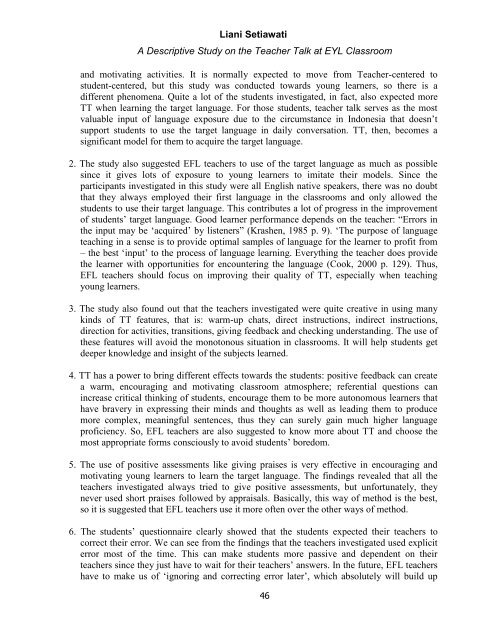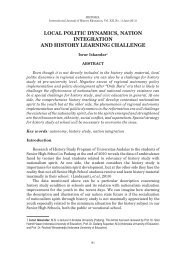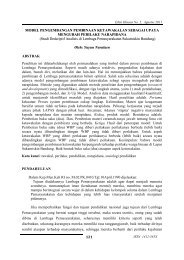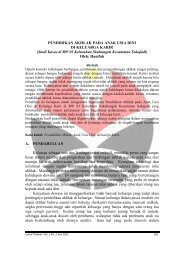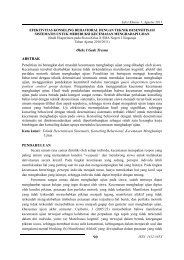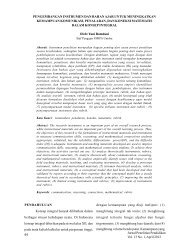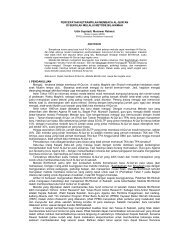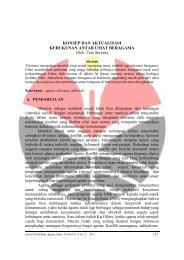a descriptive study on the teacher talk at eyl classroom - Jurnal UPI
a descriptive study on the teacher talk at eyl classroom - Jurnal UPI
a descriptive study on the teacher talk at eyl classroom - Jurnal UPI
Create successful ePaper yourself
Turn your PDF publications into a flip-book with our unique Google optimized e-Paper software.
Liani Setiaw<strong>at</strong>i<br />
A Descriptive Study <strong>on</strong> <strong>the</strong> Teacher Talk <strong>at</strong> EYL Classroom<br />
and motiv<strong>at</strong>ing activities. It is normally expected to move from Teacher-centered to<br />
student-centered, but this <str<strong>on</strong>g>study</str<strong>on</strong>g> was c<strong>on</strong>ducted towards young learners, so <strong>the</strong>re is a<br />
different phenomena. Quite a lot of <strong>the</strong> students investig<strong>at</strong>ed, in fact, also expected more<br />
TT when learning <strong>the</strong> target language. For those students, <strong>teacher</strong> <strong>talk</strong> serves as <strong>the</strong> most<br />
valuable input of language exposure due to <strong>the</strong> circumstance in Ind<strong>on</strong>esia th<strong>at</strong> doesn‟t<br />
support students to use <strong>the</strong> target language in daily c<strong>on</strong>vers<strong>at</strong>i<strong>on</strong>. TT, <strong>the</strong>n, becomes a<br />
significant model for <strong>the</strong>m to acquire <strong>the</strong> target language.<br />
2. The <str<strong>on</strong>g>study</str<strong>on</strong>g> also suggested EFL <strong>teacher</strong>s to use of <strong>the</strong> target language as much as possible<br />
since it gives lots of exposure to young learners to imit<strong>at</strong>e <strong>the</strong>ir models. Since <strong>the</strong><br />
participants investig<strong>at</strong>ed in this <str<strong>on</strong>g>study</str<strong>on</strong>g> were all English n<strong>at</strong>ive speakers, <strong>the</strong>re was no doubt<br />
th<strong>at</strong> <strong>the</strong>y always employed <strong>the</strong>ir first language in <strong>the</strong> <strong>classroom</strong>s and <strong>on</strong>ly allowed <strong>the</strong><br />
students to use <strong>the</strong>ir target language. This c<strong>on</strong>tributes a lot of progress in <strong>the</strong> improvement<br />
of students‟ target language. Good learner performance depends <strong>on</strong> <strong>the</strong> <strong>teacher</strong>: “Errors in<br />
<strong>the</strong> input may be „acquired‟ by listeners” (Krashen, 1985 p. 9). „The purpose of language<br />
teaching in a sense is to provide optimal samples of language for <strong>the</strong> learner to profit from<br />
– <strong>the</strong> best „input‟ to <strong>the</strong> process of language learning. Everything <strong>the</strong> <strong>teacher</strong> does provide<br />
<strong>the</strong> learner with opportunities for encountering <strong>the</strong> language (Cook, 2000 p. 129). Thus,<br />
EFL <strong>teacher</strong>s should focus <strong>on</strong> improving <strong>the</strong>ir quality of TT, especially when teaching<br />
young learners.<br />
3. The <str<strong>on</strong>g>study</str<strong>on</strong>g> also found out th<strong>at</strong> <strong>the</strong> <strong>teacher</strong>s investig<strong>at</strong>ed were quite cre<strong>at</strong>ive in using many<br />
kinds of TT fe<strong>at</strong>ures, th<strong>at</strong> is: warm-up ch<strong>at</strong>s, direct instructi<strong>on</strong>s, indirect instructi<strong>on</strong>s,<br />
directi<strong>on</strong> for activities, transiti<strong>on</strong>s, giving feedback and checking understanding. The use of<br />
<strong>the</strong>se fe<strong>at</strong>ures will avoid <strong>the</strong> m<strong>on</strong>ot<strong>on</strong>ous situ<strong>at</strong>i<strong>on</strong> in <strong>classroom</strong>s. It will help students get<br />
deeper knowledge and insight of <strong>the</strong> subjects learned.<br />
4. TT has a power to bring different effects towards <strong>the</strong> students: positive feedback can cre<strong>at</strong>e<br />
a warm, encouraging and motiv<strong>at</strong>ing <strong>classroom</strong> <strong>at</strong>mosphere; referential questi<strong>on</strong>s can<br />
increase critical thinking of students, encourage <strong>the</strong>m to be more aut<strong>on</strong>omous learners th<strong>at</strong><br />
have bravery in expressing <strong>the</strong>ir minds and thoughts as well as leading <strong>the</strong>m to produce<br />
more complex, meaningful sentences, thus <strong>the</strong>y can surely gain much higher language<br />
proficiency. So, EFL <strong>teacher</strong>s are also suggested to know more about TT and choose <strong>the</strong><br />
most appropri<strong>at</strong>e forms c<strong>on</strong>sciously to avoid students‟ boredom.<br />
5. The use of positive assessments like giving praises is very effective in encouraging and<br />
motiv<strong>at</strong>ing young learners to learn <strong>the</strong> target language. The findings revealed th<strong>at</strong> all <strong>the</strong><br />
<strong>teacher</strong>s investig<strong>at</strong>ed always tried to give positive assessments, but unfortun<strong>at</strong>ely, <strong>the</strong>y<br />
never used short praises followed by appraisals. Basically, this way of method is <strong>the</strong> best,<br />
so it is suggested th<strong>at</strong> EFL <strong>teacher</strong>s use it more often over <strong>the</strong> o<strong>the</strong>r ways of method.<br />
6. The students‟ questi<strong>on</strong>naire clearly showed th<strong>at</strong> <strong>the</strong> students expected <strong>the</strong>ir <strong>teacher</strong>s to<br />
correct <strong>the</strong>ir error. We can see from <strong>the</strong> findings th<strong>at</strong> <strong>the</strong> <strong>teacher</strong>s investig<strong>at</strong>ed used explicit<br />
error most of <strong>the</strong> time. This can make students more passive and dependent <strong>on</strong> <strong>the</strong>ir<br />
<strong>teacher</strong>s since <strong>the</strong>y just have to wait for <strong>the</strong>ir <strong>teacher</strong>s‟ answers. In <strong>the</strong> future, EFL <strong>teacher</strong>s<br />
have to make us of „ignoring and correcting error l<strong>at</strong>er‟, which absolutely will build up<br />
46


